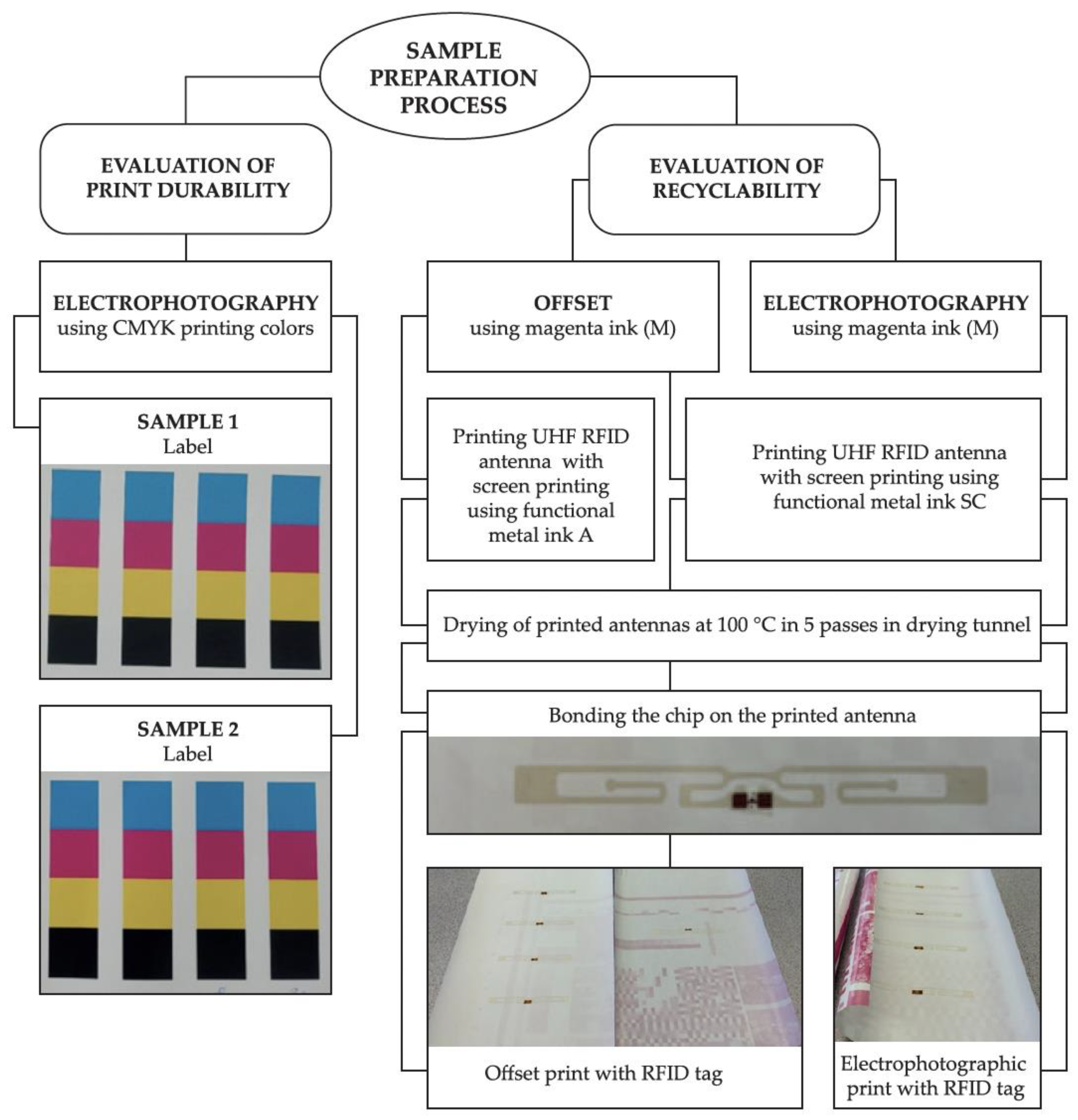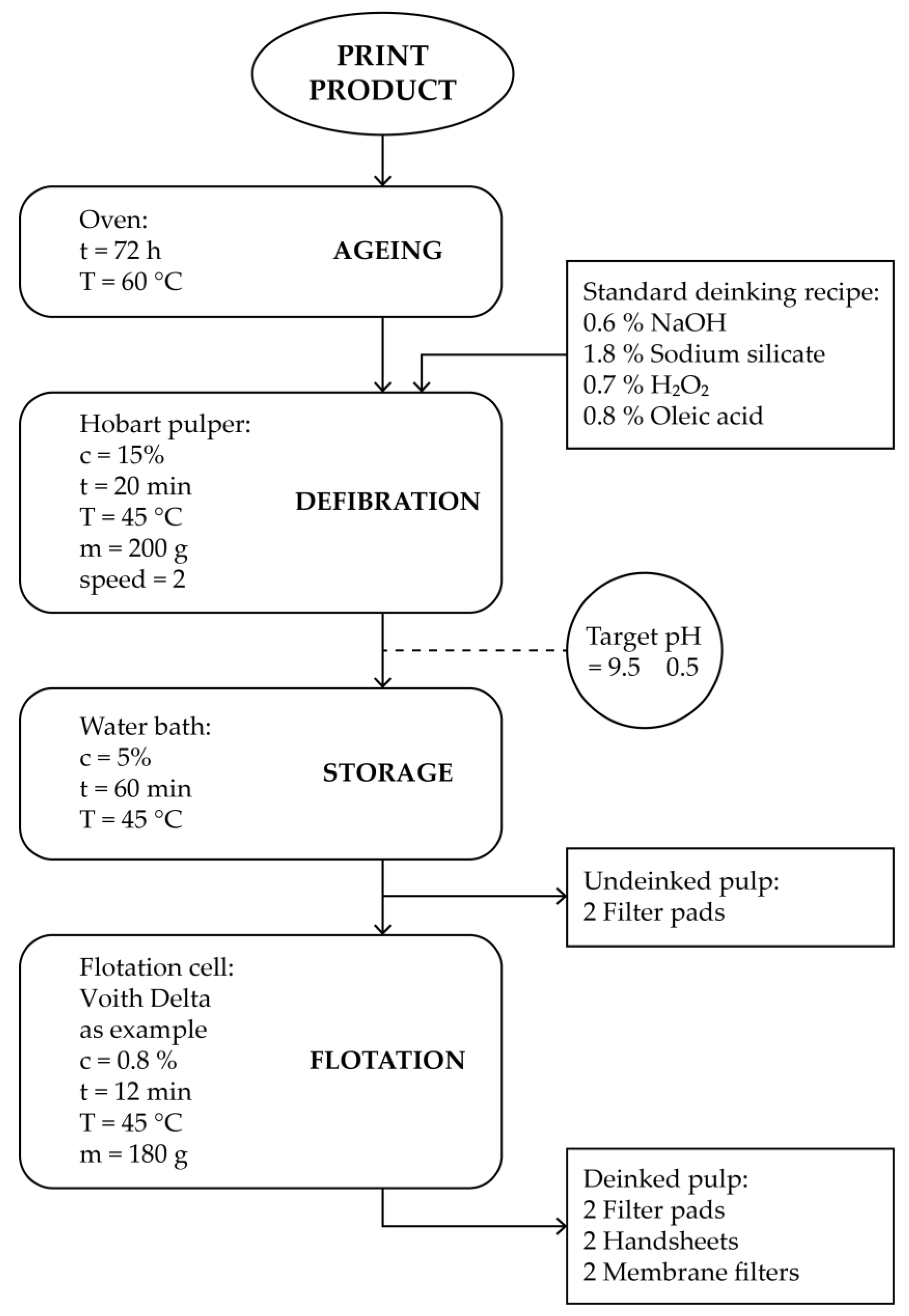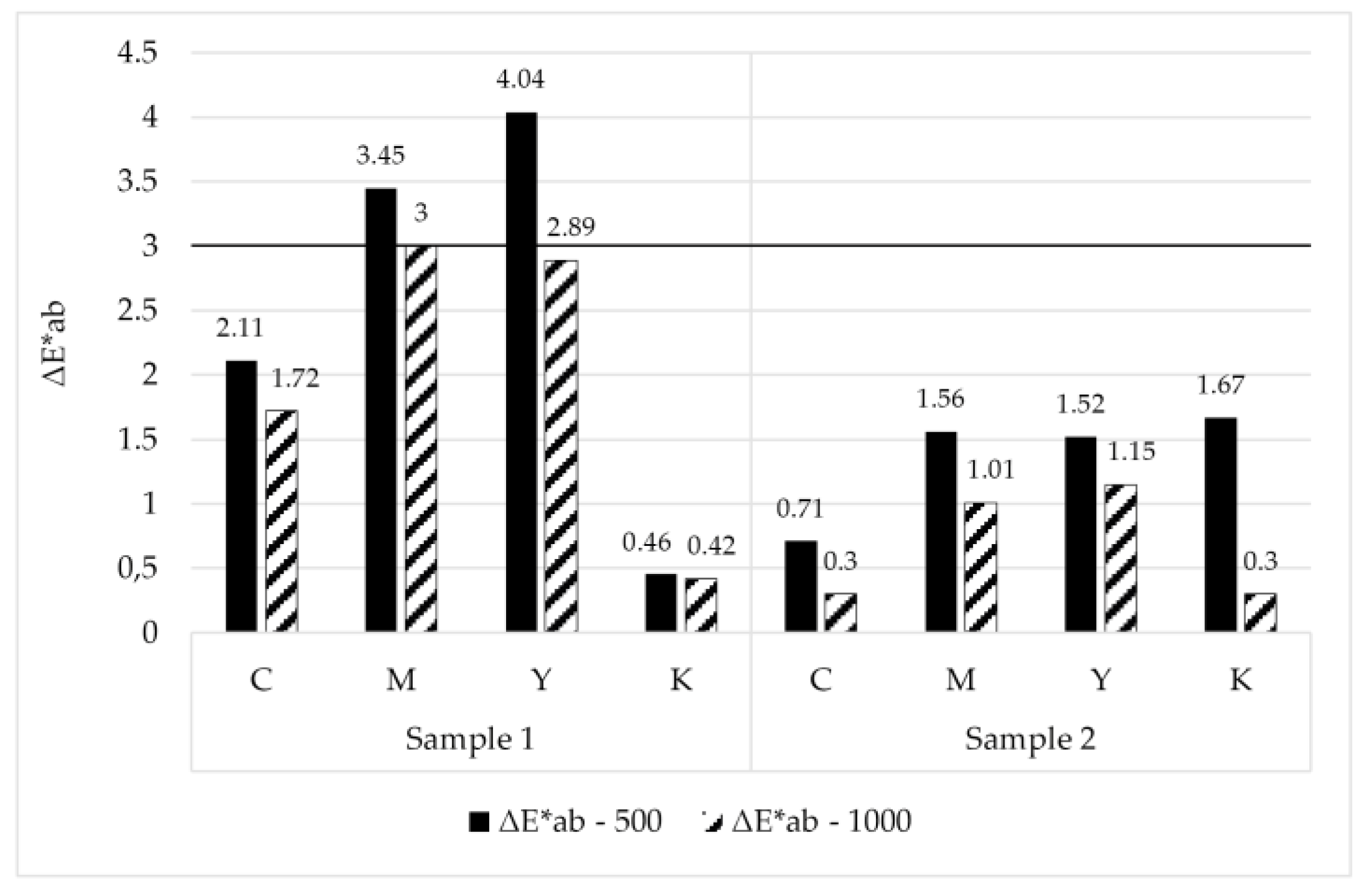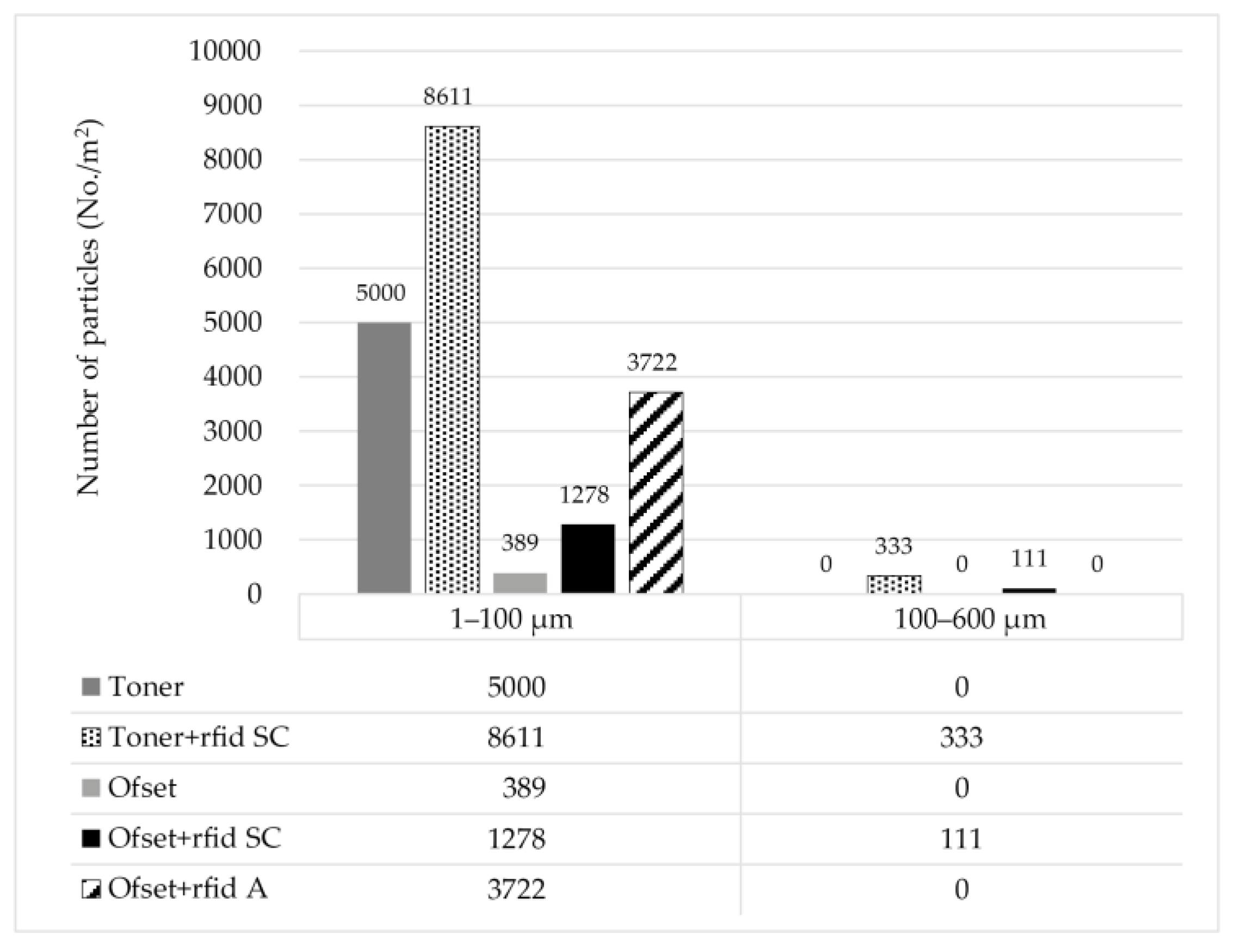Print Durability and Recyclability of Label Paper Equipped with Printed RFID Antenna
Abstract
:1. Introduction
2. Materials and Methods
2.1. Materials
2.2. Evaluation of the Durability of Prints
2.3. Evaluation of Recyclability
3. Results and Discussion
3.1. Durability
3.2. Recyclability
- ISO Brightness, a diffuse blue reflectance factor (ISO brightness) of pulps, papers, and boards, which indicates the amount of blue light reflected from the surface of the paper;
- Luminosity, describing the average spectral sensitivity of the human visual perception of brightness;
- L*a*b* values;
- ERIC value—an effective residual color concentration is a measure of the darkening effect of the remaining ink in a paper due to residual color;
- Ink elimination, IE, which indicates the ink removal rate;
- Number of dirt particles and their total surface area (ink residues).
4. Conclusions
Author Contributions
Funding
Institutional Review Board Statement
Informed Consent Statement
Data Availability Statement
Conflicts of Interest
References
- Tootelian, D.H.; Ross, K. Product Labels. J. Food Prod. Mark. 2000, 6, 25–38. [Google Scholar] [CrossRef]
- Kumar, N.; Kapoor, S. Do labels influence purchase decisions of food products? Study of young consumers of an emerging market. Br. Food J. 2017, 119, 218–229. [Google Scholar] [CrossRef]
- Kehagia, O.; Chrysochou, P.; Chryssochoidis, G.; Krystallis, A.; Linardakis, M. European consumers’ perceptions, definitions and expectations of traceability and the importance of labels, and the differences in these perceptions by product type. Sociol. Rural. 2007, 47, 400–416. [Google Scholar] [CrossRef]
- Medeiros, D.L.; Braghirolli, F.L.; Ramlow, H.; Ferri, G.N.; Kiperstok, A. Environmental improvement in the printing industry: The case study of self-adhesive labels. Environ. Sci. Pollut. Res. 2019, 26, 13195–13209. [Google Scholar] [CrossRef]
- Možina, K.; Bračko, S.; Kovačević, D.; Blaznik, B.; Možina, K. Legibility of prints on paper made from Japanese knotweed. BioResources 2020, 15, 3999–4015. [Google Scholar] [CrossRef]
- Bugner, D.E.; Gordon, S.T. Factors to consider in the design and evaluation of commercial printing inks and substrates for permanence and durability. In Proceedings of the NIP & Digital Fabrication Conference, Quebec City, QC, Canada, 9–13 September 2012; Volume 28, pp. 381–386. [Google Scholar]
- Malenica, I.; Golik Krizmanić, M.; Vukoje, M.; Kulčar, R.; Itrić Ivanda, K. Stability Aspects of UV-Curable Prints on Pressure-Sensitive Labels Facestock Made from Agro-Industrial By-Products. Macromol 2023, 3, 693–703. [Google Scholar] [CrossRef]
- Lindstrom, B.L.; Bugner, D.E. A comparison of image permanence and print durability attributes for commercial digital print materials with traditional offset. In Proceedings of the NIP 26, 26th International Conference on Digital Printing Technologie, Austin, TX, USA, 19–23 September 2010; Volume 26, pp. 400–403. [Google Scholar]
- Enninful, E.K.; Boakye-Amponsah, A.; Vanderpuye, P. An Empirical Analysis of Technology-Induced Image Fading in Digital Prints among Photography Students. Int. J. Innov. Creat. Chang. 2023, 17, 53–81. [Google Scholar]
- Beiner, G.G. Labels for Eternity: Testing Printed Labels for use in Wet Collections. Collect. Forum. 2020, 34, 101–113. [Google Scholar] [CrossRef]
- Blaznik, B.; Kovač, F.; Bizjak, G.; Bračko, S. Fastness of dye-based ink-jet printing inks in aqueous solution in the presence and absence of oxygen. Color Res. Appl. 2022, 47, 1193–1199. [Google Scholar] [CrossRef]
- Jiménez-Guerrero, J.F.; Gázquez-Abad, J.C.; Ceballos-Santamaría, G. Innovation in eco-packaging in private labels. Innovation 2015, 17, 81–90. [Google Scholar] [CrossRef]
- Nordin, N.; Selke, S. Social aspect of sustainable packaging. Packag. Technol. Sci. 2010, 23, 317–326. [Google Scholar] [CrossRef]
- Herbes, C.; Beuthner, C.; Ramme, I. How green is your packaging–A comparative international study of cues consumers use to recognize environmentally friendly packaging. Int. J. Consum. Stud. 2020, 44, 258–271. [Google Scholar] [CrossRef]
- Ervasti, I.; Miranda, R.; Kauranen, I. Paper recycling framework, the “Wheel of Fiber”. J. Environ. Manag. 2016, 174, 35–44. [Google Scholar] [CrossRef]
- Statista. Europe: CEPI Paper & Board Production. 2021. Available online: https://www.statista.com/statistics/995050/cepi-paper-board-production-europe/ (accessed on 3 July 2023).
- Ambrož, G. Razvoj Embalaže v Krožnem Gospodarstvu: Priročnik; Fit Media: Celje, Slovenia, 2019; ISBN 978-961-6283-59-5. [Google Scholar]
- Gregor-Svetec, D.; Pogačar, A.; Mirković, I.B. Reciklabilnost tiskane RFID antene na digitalnem odtisu. Pomurska Obz. 2023, 10, 39–47. [Google Scholar] [CrossRef]
- Krauchi, P.; Wager, P.A.; Eugster, M.; Grossmann, G.; Hilty, L. End-of-life impacts of pervasive computing. IEEE Technol. Soc. Mag. 2005, 24, 45–53. [Google Scholar] [CrossRef]
- Levlin, J.E.; Read, B.; Grossmann, H.; Hooimeijer, A.; Ervasti, I.; Lozo, B.; Julien Saint Amand, F.; Cochaux, A.; Faul, A.; Ringman, J.; et al. The Future of Paper Recycling in Europe: Opportunities and Limitations; Stawicki, B., Read, B., Eds.; The Paper Industry Technical Association: Bury, UK, 2010. [Google Scholar]
- Miranda, R.; Monte, M.C.; Blanco, A. Analysis of the quality of the recovered paper from commingled collection systems. Resour. Conserv. Recycl. 2013, 72, 60–66. [Google Scholar] [CrossRef]
- Vukoje, M.; Bolanča Mirković, I.; Bolanča, Z. Influence of Printing Technique and Printing Conditions on Prints Recycling Efficiency and Effluents Quality. Sustainability 2021, 14, 335. [Google Scholar] [CrossRef]
- Shankar, S.; Shikha; Bhan, C.; Chandra, R.; Tyagi, S. Laccase based de-inking of mixed office waste and evaluation of its impact on physico-optical properties of recycled fiber. Environ. Sustain. 2018, 1, 233–244. [Google Scholar] [CrossRef]
- Nie, X.; Miller, J.D.; Yeboah, Y.D. The effect of ink types and printing processes on flotation deinking efficiency of wastepaper recycling. Environ. Eng. Policy 1998, 1, 47–58. [Google Scholar] [CrossRef]
- Bajpai, P. Recycling and Deinking of Recovered Paper; Elsevier: Amsterdam, The Netherlands, 2013; ISBN 978-0-12-416998-2. [Google Scholar]
- Grossmann, H.; Handke, T.; Brenner, T. Paper recycling. In Handbook of Recycling; Elsevier: Amsterdam, The Netherlands, 2014; pp. 165–178. [Google Scholar]
- Sudheshwar, A.; Malinverno, N.; Hischier, R.; Nowack, B.; Som, C. The need for design-for-recycling of paper-based printed electronics–a prospective comparison with printed circuit boards. Resour. Conserv. Recycl. 2023, 189, 106757. [Google Scholar] [CrossRef]
- Aliaga, C.; Zhang, H.; Dobon, A.; Hortal, M.; Beneventi, D. The influence of printed electronics on the recyclability of paper: A case study for smart envelopes in courier and postal services. Waste Manag. 2015, 38, 41–48. [Google Scholar] [CrossRef] [PubMed]
- Pivar, M.; Muck, T.; Gregor-Svetec, D. Primernost recikliranih papirjev za tisk UHF RFID anten. Anali PAZU 2015, 5, 20–25. [Google Scholar] [CrossRef]
- Vidmar, T.; Muck, T.; Klanjšek-Gunde, M. Določitev optimalnih lastnosti tiskovnih materialov za tisk elektronike. Papir 2011, 39, 43–46. [Google Scholar]
- Nilsson, H.E.; Unander, T.; Siden, J.; Andersson, H.; Manuilskiy, A.; Hummelgard, M.; Gulliksson, M. System integration of electronic functions in smart packaging applications. IEEE Trans. Compon. Packag. Manuf. Technol. 2012, 2, 1723–1734. [Google Scholar] [CrossRef]
- Kim, S. Inkjet-printed electronics on paper for RF identification (RFID) and sensing. Electronics 2020, 9, 1636. [Google Scholar] [CrossRef]
- Chakraborty, M.; Nikbakhtnasrabadi, F.; Dahiya, R. Hybrid integration of screen-printed RFID tags and rigid microchip on paper. IEEE J. Flex. Electron. 2022, 1, 107–113. [Google Scholar] [CrossRef]
- Buga, C.S.; Viana, J.C. The role of printed electronics and related technologies in the development of smart connected products. Flex. Print. Electron. 2022, 7, 043001. [Google Scholar] [CrossRef]
- Hong, S.; Liu, C.; Hao, S.; Fu, W.; Peng, J.; Wu, B.; Zheng, N. Antioxidant high-conductivity copper paste for low-cost flexible printed electronics. NPJ Flex. Electron. 2022, 6, 17. [Google Scholar] [CrossRef]
- Zahid, A.; Mufti, N.; Ullah, S.; Nawaz, M.W.; Sharif, A.; Imran, M.A.; Abbasi, Q.H. IoT-Enabled Vacant Parking Slot Detection System Using Inkjet-Printed RFID Tags. IEEE Sens. J. 2023, 23, 7828–7835. [Google Scholar] [CrossRef]
- Duroc, Y. From identification to sensing: RFID is one of the key technologies in the IoT field. Sensors 2022, 22, 7523. [Google Scholar] [CrossRef]
- Meng, Z.; Li, Z. RFID tag as a sensor-a review on the innovative designs and applications. Meas. Sci. Rev. 2016, 16, 305–315. [Google Scholar] [CrossRef]
- El-Sawy, S.; Nawaz, W.; Osama, M.; Tekin, A. Low-cost thin-film passive RFID circuits and detector system. Int. J. Microw. Wirel. Technol. 2020, 12, 356–366. [Google Scholar] [CrossRef]
- Orecchini, G.; Alimenti, F.; Roselli, L.; Yang, L.; Rida, A.; Tentzeris, M.M. Green technologies and RFID: Present and future. Appl. Comput. Electromagn. Soc. J. (ACES) 2010, 25, 230–238. [Google Scholar]
- Virtanen, J.; Virkki, J.; Ukkonen, L.; Syd, L. Inkjet-printed UHF RFID tags on renewable materials. Adv. Internet Things 2012, 2, 79–85. [Google Scholar] [CrossRef]
- Ali, Z.; Perret, E.; Barbot, N.; Siragusa, R.; Hely, D.; Bernier, M.; Garet, F. Authentication using metallic inkjet-printed chipless RFID tags. IEEE Trans. Antennas Propag. 2019, 68, 4137–4142. [Google Scholar] [CrossRef]
- Kisic, M.; Dakic, B.; Damnjanovic, M.; Menicanin, A.; Blaz, N.; Zivanov, L. Design and simulation of 13.56 MHz RFID tag in ink-jet printing technology. In Proceedings of the 36th International Spring Seminar on Electronics Technology, Alba Iulia, Romania, 8–12 May 2013; IEEE: New York, NY, USA; pp. 263–267. [Google Scholar] [CrossRef]
- Lee, Y.; Kim, C.H.; Shin, D.Y.; Kim, Y.G. Printed UHF RFID antennas with high efficiencies using nano-particle silver ink. J. Nanosci. Nanotechnol. 2011, 11, 6425–6428. [Google Scholar] [CrossRef] [PubMed]
- Zhang, F.; Cui, J. UHF RFID label nanometer printing technology and its application in smart libraries. Teh. Vjesn. Tech. Gaz. 2017, 24, 1985–1990. [Google Scholar]
- Machiels, J.; Appeltans, R.; Bauer, D.K.; Segers, E.; Henckens, Z.; Van Rompaey, W.; Adons, D.; Peeters, R.; Geiβler, M.; Kuehnoel, K.; et al. Screen printed antennas on fiber-based substrates for sustainable HF RFID assisted E-fulfilment smart packaging. Materials 2021, 14, 5500. [Google Scholar] [CrossRef]
- Directive 2012/19/EU of the European Parliament and of the Council of 4 July 2012 on Waste Electrical and Electronic Equipment (WEEE). European Parliament, Council of the European Union. EU. 2012. Available online: https://eur-lex.europa.eu/LexUriServ/LexUriServ.do?uri=OJ:L:2012:197:0038:0071:en:PDF (accessed on 10 July 2023).
- Aryee, R.; Adaku, E. The reverse logistics resource matrix: A novel classification scheme. J. Manuf. Technol. Manag. 2023, 34, 435–454. [Google Scholar] [CrossRef]
- Andersen, T. A comparative study of national variations of the European WEEE directive: Manufacturer’s view. Environ. Sci. Pollut. Res. 2022, 29, 19920–19939. [Google Scholar] [CrossRef]
- Schnideritsch, H.; Luidold, S.; Angerer, T.; Fasching, M.J.; Antrekowitsch, H. Problematik der Aufbereitung von RFIDs. In Recycling und Rohstoffe; Chair of Nonferrous Metallurgy: Leoben, Austria, 2012; pp. 625–636. [Google Scholar]
- Hakola, L.; Hakola, E.; Palola, S.; Tenhunen-Lunkka, A.; Lahtinen, J. Durable and sustainable smart tags for identity management and condition monitoring: Case study for reusable packaging and recyclable data carriers. Packag. Technol. Sci. 2023, 1–15. [Google Scholar] [CrossRef]
- Bukova, B.; Tengler, J.; Brumercikova, E.; Brumercik, F.; Kissova, O. Environmental Burden Case Study of RFID Technology in Logistics Centre. Sensors 2023, 23, 1268. [Google Scholar] [CrossRef]
- Verbelen, Y.; Boardman, M.; Andrade, H.D.; Mackenzie, R.; Wallace-Smith, T.; Kaluvan, S.; Hutson, C.; Osbourne, S.; Bickerton, I.; Fox, N.; et al. Closed-Loop Recycling Process Flow for Diamond Betavoltaics. In Proceedings of the Yazami International Symposium, Phuket, Thailand, 27 November–1 December 2022. [Google Scholar]
- Steltenkamp, V.; Wens, B.; Anhalt, A.; Schindler, H.R.; Schmalbein, N.; Cave, J. SMART TRASH: Study on RFID Tags and the Recycling Industry; RAND Corporation: Santa Monica, CA, USA, 2012. [Google Scholar]
- Furuta, T.; Tonooka, H.; Kobayashi, M. Research on Recycling Cardboard with RF Tags/Labels. In Proceedings of the Eighth International Conference on EcoBalance, Tokyo, Japan, 10–12 December 2008. [Google Scholar]
- Southwell, J. Recycling of RFID-Tagged Corrugated Packaging. Available online: https://www.fibrebox.org/upload/2009/Tagged%20Corrugated%20and%20Recycling%20Southwell%20DRAFT%20Presentation.pdf (accessed on 10 April 2023).
- Huttle, W.K. The Impact of RFID Tags on the Recycling of Corrugated Containers. Available online: https://www.fibrebox.org/upload/2009/PIRArfid.pdf (accessed on 10 July 2023).
- Atkinson, J.E. Fate of Conductive Ink Pigments during Recycling and Landfill Deposition of Paper-Based Printed Electronics; Western Michigan University: Kalamazoo, MI, USA, 2017. [Google Scholar]
- Déprès, G.; Thénot, V.; Pitiot, B.J.; Dumont, C.; Marlin, N.; Curtil, D.; Reverdy-Bruas, N. Recycling of paper electronics in standard paper and board recycling lines. IEEE J. Flex. Electron. 2023, 2, 18–24. [Google Scholar] [CrossRef]
- ISO 5630-3:1996; Paper and Board—Accelerated Ageing—Part 3: Moist Heat Treatment at 80 Degrees C and 65% Relative Humidity. International Organization for Standardization: Geneva, Switzerland, 1996.
- ISO 12040:1997; Graphic Technology Prints and Printing Inks Assessment of Light Fastness Using Filtered Xenon Arc Light. International Organization for Standardization: Geneva, Switzerland, 1997.
- ASTM D5264-98(2019); Standard Practice for Abrasion Resistance of Printed Materials by the Sutherland Rub Tester. ASTM International: West Conshohocken, PA, USA, 2019.
- INGEDE Method 11: Assessment of print product recyclability—Deinkability test. In Enhancing Paper Recycling in Europe: Optimising Paper Products, Packaging and Collection Systems Outcome–Guidelines and Recommendations EcoPaperLoop Project; European Regional Development Fopund: Brusselss, Belgium, 2014; pp. I-65–I-78. Available online: https://www.ecopaperloop.eu/outcome/EcoPaperLoop-Complete.pdf (accessed on 10 April 2023).
- ISO 2470-1:2016; Paper, Board and Pulps. Measurement of Diffuse Blue Reflectance Factor. Part 1: Indoor Daylight Conditions (ISO Brightness). International Organization for Standardization: Geneva, Switzerland, 2016.
- ISO 5631-2:2022; Paper and Board. Determination of Colour by Diffuse Reflectance. Part 2: Outdoor Daylight Conditions (D65/10°). International Organization for Standardization: Geneva, Switzerland, 2022.
- ISO 15755:1999; Paper and Board—Estimation of Contraries. International Organization for Standardization: Geneva, Switzerland, 1999.







| Designation | Description |
|---|---|
| toner | recycled digital print |
| toner + rfid SC | recycled digital print with RFID tag printed with SunChemical ink |
| ofset | recycled offset print |
| ofset + rfid SC | recycled offset print with RFID tag printed with SunChemical ink |
| ofset + rfid A | recycled offset print with RFID tag printed with Agfa ink |
| rfid SC | recycled unprinted paper with RFID tag printed with SunChemical ink |
| rfid A | recycled unprinted paper with RFID tag printed with Agfa ink |
| L* | a* | b* | C* | h | D | |||
|---|---|---|---|---|---|---|---|---|
| Label paper | Sample 1 | 91.64 | −1.26 | −21.87 | 21.91 | 267 | / | |
| Sample 2 | 92.77 | −0.74 | −22.31 | 22.32 | 268 | / | ||
| CMYK prints | Sample 1 | C | 49.97 | −24.44 | −62.74 | 67.34 | 249 | 1.607 |
| M | 42.55 | 70.95 | −16.84 | 72.92 | 347 | 1.495 | ||
| Y | 83.08 | −12.37 | 81.11 | 82.05 | 99 | 1.398 | ||
| K | 14.74 | −1.21 | −6.51 | 6.62 | 259 | 1.706 | ||
| CMYK prints | Sample 2 | C | 52.80 | −27.22 | −64.29 | 69.82 | 247 | 1.686 |
| M | 43.30 | 74.50 | −20.19 | 77.19 | 345 | 1.510 | ||
| Y | 84.90 | −12.66 | 84.41 | 85.35 | 99 | 1.439 | ||
| K | 9.29 | −1.46 | −4.82 | 5.03 | 253 | 1.957 | ||
| Light | Moist-Heat | Dry-Rub | |||||
|---|---|---|---|---|---|---|---|
| ΔD—72 | ΔD—144 | ΔD—72 | ΔD—144 | ΔD—500 | ΔD—1000 | ||
| CMYK prints Sample 1 | C | 0.005 | 0.020 | 0.193 | 0.194 | −0.017 | −0.007 |
| M | −0.020 | −0.029 | 0.118 | 0.136 | −0.006 | 0.003 | |
| Y | −0.049 | −0.063 | 0.042 | 0.064 | −0.016 | 0.008 | |
| K | 0.0006 | 0.006 | 0.299 | 0.306 | −0.007 | −0.003 | |
| CMYK prints Sample 2 | C | −0.005 | −0.021 | 0.026 | 0.024 | −0.033 | −0.064 |
| M | −0.015 | −0.057 | 0.054 | 0.057 | −0.022 | −0.026 | |
| Y | −0.017 | −0.080 | 0.042 | 0.029 | −0.029 | −0.039 | |
| K | 0.0066 | −0.011 | 0.092 | 0.090 | −0.045 | −0.037 | |
| Luminosity (%) | ISO Brightness (%) | L* (/) | a* (/) | b* (/) | ERIC (ppm) | IE (%) | |
|---|---|---|---|---|---|---|---|
| toner | 64.7 | 82.8 | 84.4 | 1.14 | −3.11 | 553 | 22.7 |
| toner + RFID SC | 62.6 | 80.4 | 83.2 | 1.07 | −2.93 | 638 | 37.1 |
| offset | 64.4 | 81.7 | 84.1 | 2.36 | −3.62 | 503 | 30.7 |
| offset + RFID SC | 61.1 | 80.7 | 82.3 | 1.83 | −3.49 | 685 | 27.6 |
| offset + RFID A | 79.9 | 82.1 | 91.6 | 8.25 | −1.64 | 90 | 44.4 |
| RFID SC | 81.1 | 83.4 | 92.3 | 0.78 | −1.66 | 88 | 6.0 |
| RFID A | 80.7 | 83.5 | 89.0 | 0.59 | −1.78 | 105 | 5.4 |
Disclaimer/Publisher’s Note: The statements, opinions and data contained in all publications are solely those of the individual author(s) and contributor(s) and not of MDPI and/or the editor(s). MDPI and/or the editor(s) disclaim responsibility for any injury to people or property resulting from any ideas, methods, instructions or products referred to in the content. |
© 2023 by the authors. Licensee MDPI, Basel, Switzerland. This article is an open access article distributed under the terms and conditions of the Creative Commons Attribution (CC BY) license (https://creativecommons.org/licenses/by/4.0/).
Share and Cite
Pogačar, A.; Bolanča-Mirković, I.; Gregor-Svetec, D. Print Durability and Recyclability of Label Paper Equipped with Printed RFID Antenna. Sustainability 2024, 16, 129. https://doi.org/10.3390/su16010129
Pogačar A, Bolanča-Mirković I, Gregor-Svetec D. Print Durability and Recyclability of Label Paper Equipped with Printed RFID Antenna. Sustainability. 2024; 16(1):129. https://doi.org/10.3390/su16010129
Chicago/Turabian StylePogačar, Andreja, Ivana Bolanča-Mirković, and Diana Gregor-Svetec. 2024. "Print Durability and Recyclability of Label Paper Equipped with Printed RFID Antenna" Sustainability 16, no. 1: 129. https://doi.org/10.3390/su16010129
APA StylePogačar, A., Bolanča-Mirković, I., & Gregor-Svetec, D. (2024). Print Durability and Recyclability of Label Paper Equipped with Printed RFID Antenna. Sustainability, 16(1), 129. https://doi.org/10.3390/su16010129







